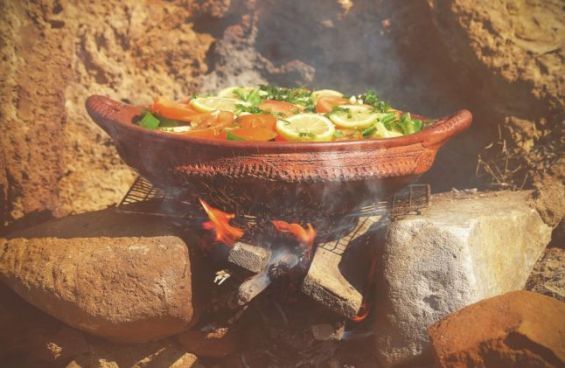Like many other aspects that distinguish the lifestyles, traditions and habits of Moroccans, food in the North African Kingdom has been influenced by the changes that marked history. Conquests, refugees, wars and trade, all of these factors contributed to the current versions of our pillar dishes, including Bastilla, Tagine and Couscous.
These three dishes have evolved throughout the years, thanks to Jews expelled from Spain, Arab conquests and the Ottoman influence in the Mediterranean.
Bastilla, imported from Al Andalus
Pillar dishes of modern-day Moroccan cuisine say a lot about the history of the region and the different components of the Moroccan culinary traditions. Bastilla is the perfect example one can use to demonstrate the different political events that shaped the course of history.
Although it sounds like an Arabic word, the dish was brought to Morocco from Spain which is why it is called in different ways. From Bastilla to pastilla and other variations, the name of this popular rounded pie first emerged after the Reconquista, a period that ended with the fall of the Nasrid kingdom of Granada to the expanding Christian kingdoms in 1492.
In their book «Colour of Maroc: A celebration of food and life» (Allen & Unwin, 2014), Rob and Sophia Palmer recall that «at the time of the Christian Reconquest of the Islamic States in the Iberian Peninsula- that is Spain and Portugal- in the 13th century, the Muslims and Jews who fled to Morocco brought with them culinary refinements to the cuisine».
«The magical dish of b’stilla, with the crisp outer shell of warka pastry and layers of meat and eggs, is one such dish», the two authors recalled.

But to other culinary historians, the dish, which incorporates sliced pigeon with eggs, almonds and spices, has long been associated with the Jews of Morocco, expelled, as well, from Al Andalus. Some of these authors refer to Bastilla as a «Sephardi pastel».
According to American food historian Gil Marks, it was the Sephardim who «brought pastille to Morocco». In his book «Encyclopedia of Jewish Food», Marks recalls that while «Sephardim continued to pronounce the name with a P, Arabic speakers substituted a B».
«The pie was baked or, for those without access to an oven, adapted to be fried in a large skillet», wrote the same historian.
Among the Moroccan-Jewish community, Bastilla used to be a dish for special occasions. Marks indicates that that is mainly linked to the fact that it is «labor-intensive». Indeed, Sephardi Jews cook pastillas in Morocco to celebrate Sukkat, a biblical Jewish holiday celebrated on the 15th day of the seventh month, Tishrei, Hannukkahs and weddings.
Tagine, the Thousand and One Nights dish
It is a delicious dish to say the least and an ancient one that is mostly associated to the indigenous people of North Africa. But the name of this dish, served in an earthenware pot, goes back to the ancient times, when the Greek civilization influenced the culinary habits of Mediterraneans.
To the «Encyclopedia of Kitchen History», (Routledge, Dec 29, 2004), by Mary Ellen Snodgrass, Tajine or Tagine is a borrowed version of the Greek word «Teganon», which means «fry pan» and refers to the serving vessel of the dish itself.
Indeed, the same Encyclopedia indicates that this modern-day famous dish «consists of a shallow footed terra cotta bowl covered by a perforated lid, which remains in place over hours of slow dry heating».
References to this pot, dish and its amazing technique date back to the era of the fifth Abbasid Caliph Harun al-Rachid, who ruled during the eighth century. Furthermore, Tagine was also mentioned in one of the most famous collections of Middle Eastern folk tales.

According to Snodgrass, «foods cooked tagine-style appear in Alf Layla wa Layla (One Thousand and One Nights), an Arabic story collection begun in the ninth century CE».
Tagines, like other Moroccan and North African dishes, were influenced by the changes that the region went through. Scottish food author and cook Chillie Basan indicates in her book «Tagines & Couscous : Delicious recipes for Moroccan one-pot cooking», (Ryland Peters & Small, 2015), that the Berber dish «has evolved with the history of the region».
According to her, these changes came with «waves of Arab and Ottoman invaders, Moorish refugees from Andalusia and French colonialists».
Arab conquests, for example, have contributed in bringing spices to Morocco, such as ginger, nutmeg, cinnamon black pepper and clove, wrote Rob and Sophia Palmer.
According to them, Arabs have also been responsible for marrying sweet and sour, when cooking Tagines. «Under the Arabs, we see the development of dishes that are now famed as the classics of Moroccan cookery with sweet and sour pairings such as tagines of chicken with olives and lemons, beef with walnuts and lamb with apricots».
The same thing happened with the Ottomans. The two authors recall that although the «Ottomans never successfully captured any part of modern-day Morocco, they did reach its borders in the 16th century and their culinary craft filtered down the Northern ports».
Here, Rob and Sophia Palmer refer to «the city of Tetouan, where we see the dish Tagine t’affia (…) sweetened with sugar and raisins and topped with fried almonds».
Couscous, a Maghreb pasta dish
Although three Maghreb countries often argue over the origins of this dish, they all agree that Couscous is a North African specialty.
«Culinary historian Lucie Bolens refers to primitive pots of Couscous found in graves dating back to the reign of Berber king Massinissa, who ruled between 238 and 149 BC. This North African region was particularly prosperous and was considered the Attic of Rome», wrote a platform called Les Délices du Maroc.
However, according to the book «Manger au Maghreb : Approche pluridisciplinaire des pratiques de table en Méditerranée du moyen-âge à nos jours, Partie 1» (Presses Univ. du Mirail, 2006) the dish is a variety of pasta, which has Western Arab origins.
The book describes the variety as a «typical form of the cuisine of the Maghreb and Al-Andalus, and whose distant origins are probably-at least for Couscous, from western or central Maghreb (Morocco, Algeria)».
To the book, Couscous «was not famous before the twelfth-thirteenth century, although the word Taam (food or couscous) was used during the tenth century».
«The use of the word ta'am for Couscous was confirmed in the twelfth century in an important book on the life of the Moroccan mystics, the Tasawwuf (Sufism, Ed) of Abi Ya'Kub Tadili nicknamed Ibn a-Zayyat, written in 1220-1221 (...) Some references related to the Moroccan Atlas, at the time of Almoravids, emphasize that ta'am was already a common dish among Berbers».
For his part, Mohamed Houbaida, author of «Vegetarian Morocco, 15th-18th centuries : History and biology» (Eddif, 2008) the dish dates back to the sixteenth, seventeenth and eighteenth centuries, adding that it even reached «Italy, Spain, France and England».
«An Italian recipe for Couscous by Bartolomeo Scappi, the cook of Pope Pius V, dated 1570, speaks of a semolina reduced in grains, steamed in a pan with a holed bottom, seasoned with a broth of cow meat, of mutton and pork, and sprinkled with grated cheese, sugar and cinnamon».
The same source assures that another Spanish recipe for Couscous is mentioned in the book of Fransisco Martinez Montino, the cook of Philip III, King of Spain, written in 1611.

«France, for example, discovered Couscous at the end of the 17th century through Moroccan ambassador Ben Aïcha when the newspapers of the time described his favorite meal», the same book recalls.
He also stresses that «Couscous, which seems to be of Berber origin, is a Maghreb meal par excellence».
«The Maghreb people has been cooking it from the oasis of Mzab in southern Tunisia to Marrakech in southern Morocco and since the tenth and eleventh centuries. But it was not until the fifteenth century, especially for Morocco, that Couscous gained fame, according to Mohamed Oubahli as being the basis of the daily diet of both laymen and elites», Houbaida concluded.





 chargement...
chargement...













